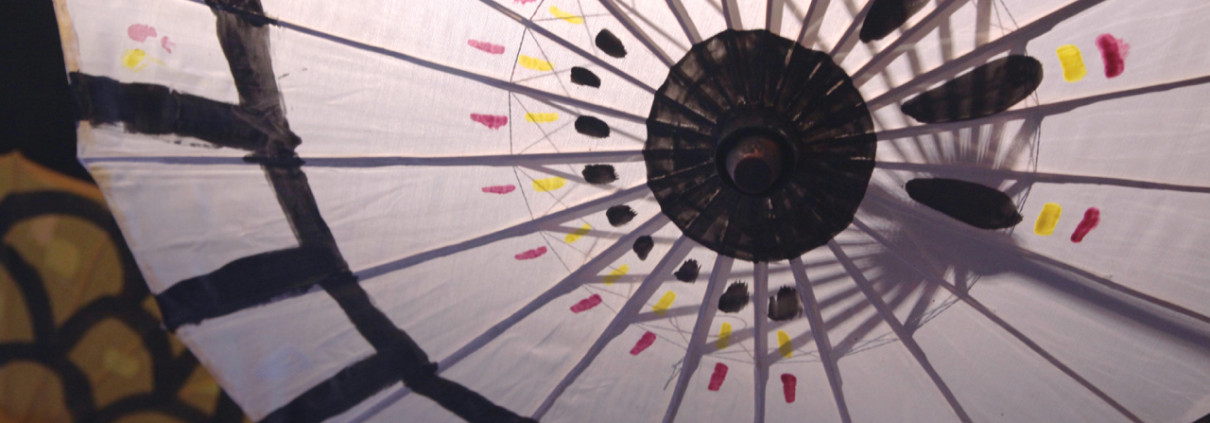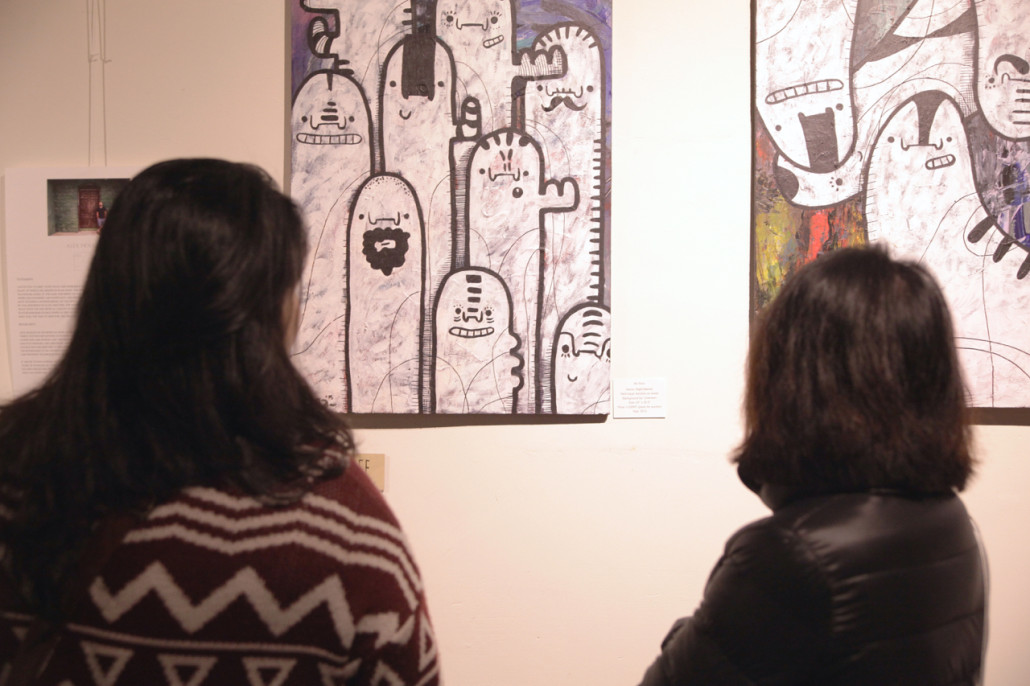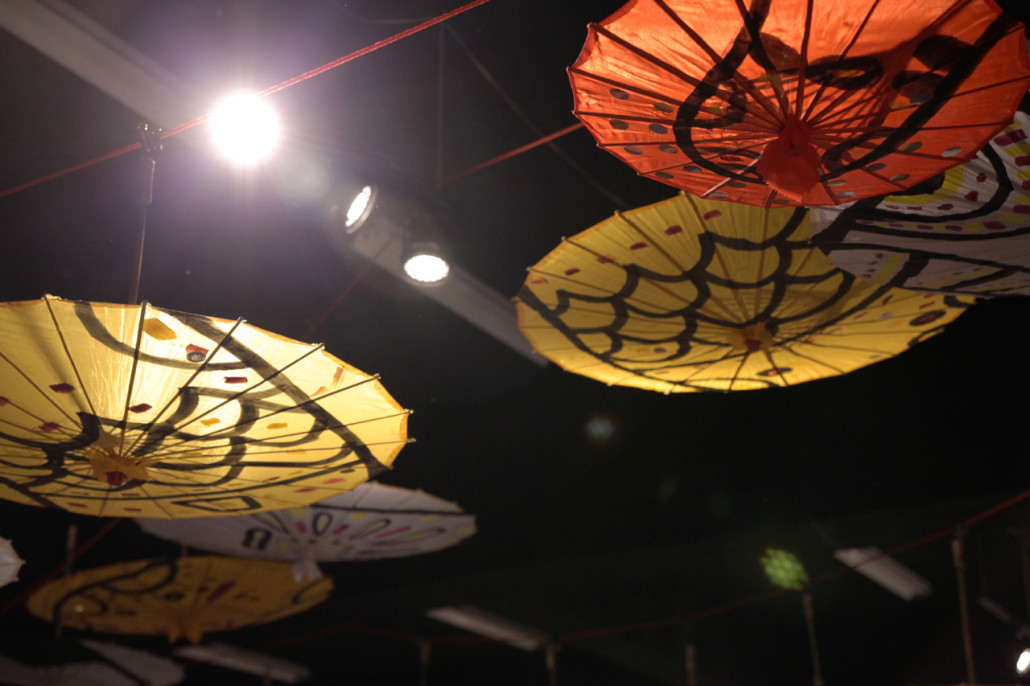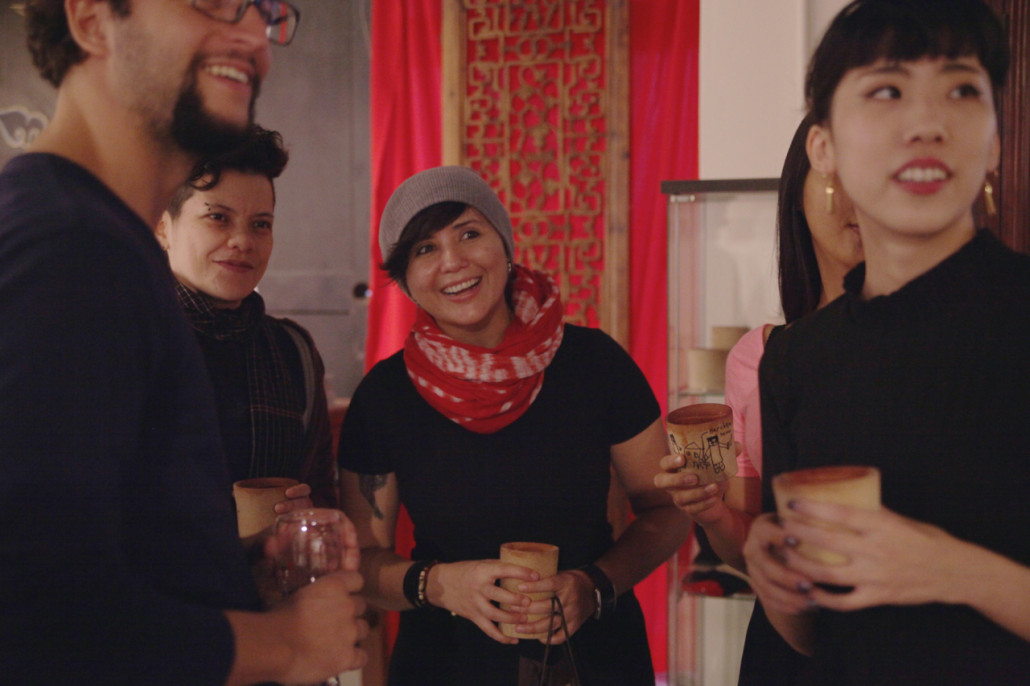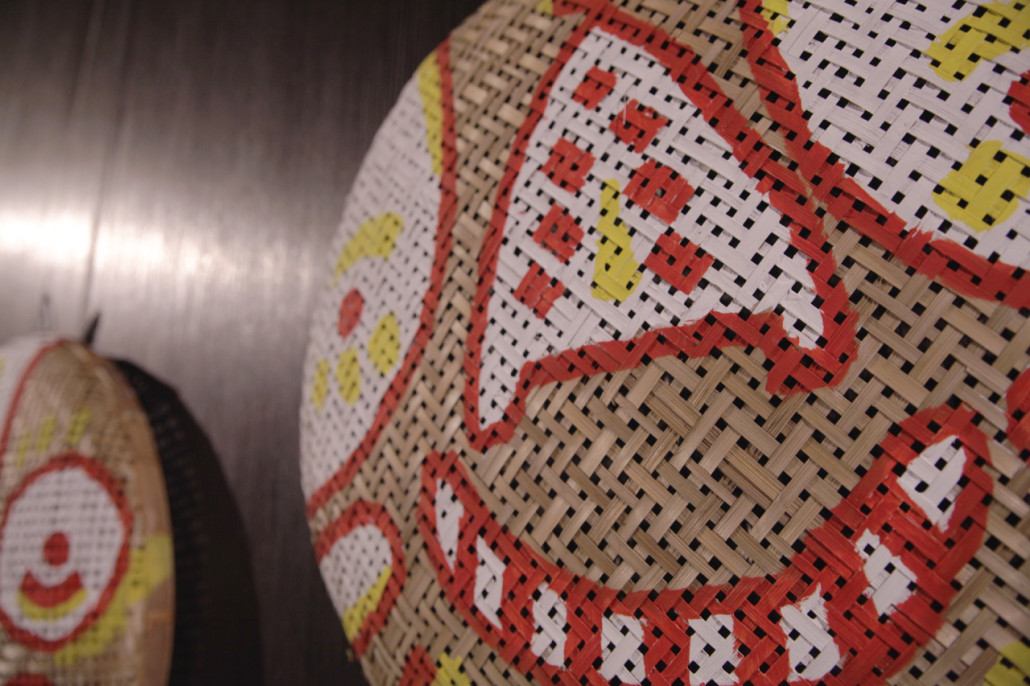VD XXIV – Carol Christie, Charles Haines, Joyce Liu

Bio:
A self taught artist, Carol Christie is new to painting having delved into it only in the last 4 years.
Vibrant colour is her inspiration as well as texture. She uses acrylic, charcoal, chalk and oil pastel and collage techniques on paper and canvas.
As well as living in the beautiful and wild East Coast of New Zealand, Carol has travelled to many places in the world and has lived in Asia for more than 12 years – colour, texture, flavour, light and feel all have their influence.
Now living and teaching in Taipei.
Has previously exhibited at Café Vergissmeinicht in 2016.
Whatever will happen next………
Statement:
Diving Deeper
I discovered the painter in me in the last few years……moving to Taiwan to start another chapter created a space to dive in and go for it
I have always loved colour and have always created ……..be it gardens, houses, writing, knitting, sewing, drawing and painting with 5 year olds but had never painted for myself
I have made up for lost time experimenting with any materials I can get my hands on – oil, acrylic, collage, pastel, charcoal, paper, canvas – large and small
You can never quite tell what will happen and what the end result will be as each piece has a life and story of its own as it unfolds before you
There is tension and struggle as you try to control the materials but in the end you must surrender to colour, the push and pull and the way it sings
Be bold
Be fierce
Dive in
Visual Dialogues XXIV
Carol Christie, Charles R. Haines, and Joyce Liu

Artist Bio
Charles R. Haines has two spirits that work together in his art. One is the crow spirit that has been part of him for many years. The other spirit is an Indiginous spirit. These two fuse together to give him his creative energy. It is with this energy he creates his art.
Charles creates in many mediums, though these days mostly in acrylic and marker. He has been known to carve wood, work leather and shape iron. His artistic spirits are happiest when he is creating and so he draws everyday.
Artist Statement
The Crow Spirit has awakened.
It stirs inside me and speaks
Drives me to create.
It can not be silenced. It will not stop unless I put brush to canvas, pen to paper, or chisel to wood.
Only then is the spirit satisfied.
My art is a result of this spirit inside me.
I must listen to its call.
Charles Haines
murder.of.crows.10.5@gmail.com
Visual Dialogues XXIV
Carol Christie, Charles R. Haines, and Joyce Liu
Meet the Artist: Ale Bara
Born in Guatemala, Ale Bara, a self-described nomad with “itchy feet”, has lived and created art in countries across Europe and North America, and chose to come to Taiwan after leaving Kenya. Formally trained in industrial design, Bara paints not for financial success, but because she likes it. Since her childhood, she has filled sketchbooks with comics and today she paints not only to communicate to the world but also to escape to another one. One she hopes will make her audience smile, just as the people who crossed her path have.
Her first foray into creating art outside of her sketchbooks happened in 2004 when Under Dusken, a Norwegian magazine, hired her to create comic accompaniments for their articles. Today, many of her pieces depict funny characters she’s adapted from real life and depicted in a whimsical, colorful way.
Since then Bara has exhibited her art the world over, her itchy feet leading her to discover new techniques, people and lifestyles in each new place which she has integrated. Often her illustrations reflect something idiosyncratic about the country she resides, the comic exhibited at the Red Room depicting a foreign character trying stinky tofu and navigating Taiwan’s motorcycle filled traffic is one example of this.
The umbrellas that continue to adorn the Red Room are another example of her creative incorporation. Initially created for the Chinese New Year, put together these umbrellas create a giant goat which cares for everyone from its vantage point in the heavens. Perhaps most inspiring to her about Taiwan is the dedication to artisanship and handcrafts. “Everything in Taiwan is so well done,” she said. “I would love for my work to be like that.” Since coming to Taiwan she has increasingly experimented with different materials from rice baskets to bamboo to giant canvases.
In the interview below, Bara speaks a little bit more about her personal art style and how she became involved with the Red Room.
You developed this world full of these characters that are inspired by the people you see in everyday life. How has your style evolved over the years?
Well I have moved a lot, so I think it depends on the people who have crossed my path. They make my style different.
I started doing the noses on the characters I have now when I was in Kenya, because I just saw big noses everywhere. The bald heads also are influenced by Kenya because a lot of people shaved their heads there.
[Every time I travel I see] the people, the features, the color– everything is different– so I think I just start grabbing things from every culture. [I look at] the way people are, the way people dress and react and I think that’s what changes my style, just traveling.
Do you think switching from digital to a hand drawn method has made you think more carefully about what you choose to include?
Well I think digital work is much easier. Everything is possible. So with painting by hand you have to know how to do a lot of stuff so it takes a while for you to get there. I’m trying to paint by hand, but I don’t have technique, so it’s just lots of color and very, very simple. I hope someday I will develop a technique.
At the beginning I did think more carefully because when I draw in my sketchbooks I really like them really neat. I started drawing with pencil and erasing and drawing and erasing. Then I thought, well, mistakes can be a beautiful thing, so now I only draw with pen. If I make a mistake I try to think of how to fix it and how to make it part of my piece.
Now it doesn’t really make me think more, it makes my piece become something different than what I thought at the beginning.
I noticed on your website that you did an exhibition and the materials were rescued from the recycling bin. What motivated you to do that and how do you feel using those materials, rather than something purchased for the store, changed your art or improved it?
I think it’s because I’m all about recycling and not spending money if I don’t have to. When I was living in New York I started seeing all these things that people threw out. In New York they just put it on the sidewalk so someone else can take it. You would just be walking and find amazing things that you could paint on.
It has worked very well and I think it looks really nice. It gives live to something that for someone was dead before.
What is your favorite thing that you resurrected or transformed? Is there anything that stands out?
I have painted so many things. I didn’t find it in the street, but I found some bamboo spoons that I really like. So I think I like painting on bamboo—the texture is really cool and the color of the bamboo is really nice.
How did you start developing your characters in 2004?
When you are an illustrator you have to start developing a style because they hire you based on your style, but I do have different styles like you can see in the exhibition.
Like the zodiac collection, I had never drawn animals before. I didn’t quite like the result, but that’s what turned out. I just keep experimenting and seeing what I can do.
How do you deal with and move from art which your unsatisfied? What was your response to the zodiac collection?
I have the ability to move on quickly and to just let go. It didn’t turn out how I wanted “okay, let’s exhibit and see what people think of it”. Some people liked it even though I didn’t; they bought most of the collection.
I just put it out and some people like it and some people don’t. You must find a home for whatever you have.
You mentioned there are moments when you don’t like the end result, but are there moments where you’re uncertain throughout the process but love the results?
Yeah, most of the time. I think I have a problem because I don’t like doing the same things.
Everything I do is just an experiment. When I started trying to sell my art some people told me “you know you should just do this style and stick to it because that’s what people like”, but that doesn’t really make me happy. Sometimes you like red and sometimes you like blue, so why always stick with red just to satisfy people?
Now I don’t care about people that much, unless it’s a commission. Sometimes it’s really hard to do commissions because sometimes you just don’t want to draw, or you just see something that inspires you and you want to draw exactly that.
Are there ever moments during a commission where you feel you’ve discovered a part of you that you wouldn’t have otherwise discovered because you were forced to think in another way?
Sometimes, but very few times, like right now I have a commission with zodiac animals. I really didn’t want to do them because I didn’t really like the other ones so I really cracked my head and thought about it and sketched. The [end] result was awesome! I really liked it.
Ultimately the clients have to trust me. I always tell them I have to do my own stuff. I’ve lost clients because they’ve told me to do something else and I’ve refused. I refuse to do something I’m not passionate about.
What do you hope your art communicates? Does it change with each piece of art you complete or is there a general feeling you hope to evoke in people?
I just paint because it makes me feel really good. When I’m angry or sad, I paint and everything just goes away. For me, drawing has been an escape from this kind of weird world; that’s why I draw. That’s the way I communicate. I’m very introverted, so I can make a drawing for you if you want me to say something.
I describe my art as funny and quirky. I just want to make people smile when they see because they make me smile. That’s it . Very simple.
How were you approached for Visual Dialogues?
I’m always willing to participate and give a hand, so Red Room always calls me to see if I’m free to do stuff and I’m always free to do stuff.
Originally, I wasn’t going to take part in Visual Dialogues because I thought I didn’t have something to share. Then Charles wrote me and asked me to participate. He said I’d be perfect for the last one. It’s mutual participation. They call me and I’m eager to just be there and paint.
How do you think the Red Room community has affected your art at all? Has being in the community beyond painting changed anything for you?
Yeah, actually, I had to paint on a big canvas for Artists Break the Mold and Artists Break the Flood.
I’d only painted on small things because they take less time and I’m impatient. I thought final piece on the big canvas was awesome. I really like how my characters looked. Even though I’d done murals, it was different on the canvas.
I think that’s how Red Room has helped. They’ve kind of encouraged me to paint on a big scale. The pieces in Visual Dialouges, the big ones, I wouldn’t have decided to do before because I had never experienced it. I experienced it with Red Room.
[At the Red Room] artists are experiencing mural paintings, big canvas paintings, and other sort of mediums. Red Room is giving them the opportunity to do that which is just pretty cool.

玉米
1991年出生於基隆市
2010年加入台大登山社
2014年畢業於台灣大學生化科技系
2014年於下田窯向 徐興隆老師與 洪瑩琪老師拜師學陶兩年
2016年創立迷你窯工作室
作為一個冒險家,我爬山,我溯溪,我攀岩,我樂於奔向自己的所愛。
作為一場人生冒險的開始,我選擇了不平凡的荊棘之路。大學的最後一年,我拋下一切,挑起了一場人生的賭博,賭的是夢想的實踐、博的是不後悔的人生與渴望創作的悸動。曾經挨餓,曾經迷惘,曾經害怕,曾經痛哭,我一步步地拔除身上的刺,一步步的越挫越勇,終於有了機會辦了第一場展覽,雖小卻美,更是我短短三年邁向陶藝創作之路的里程碑。
如果沒有當初放手一搏,今日恐怕來的更晚,甚至不會實現
Joyce
1991 Born in Keelung City
2010 Join to the NTU mountain club
2014 Graduated from Department of Biochemical Science and Technology, NTU
2014 Learned potteries from 徐興隆and 洪瑩琪 in 下田窯
2016 Set up 迷你窯
As an adventurer, I go mountain climbing, river tracing, rock climbing. I enjoy doing what I love.
As a beginning of my life adventure after graduating, I chose a much harsher way-a thorny road to my freedom. In the last year of my college, I cast away all my own profession and devoted to a whole different art world. It’s literally like the gamble. Gamble on my dream, Walk through the life without regret and my heart burns again for creation.
Even though, I was once lost, confused, terrified, and even shed tears. Step by step, I lived, savored every difficulty and consumed. I believe that the more frustrated I am, the stronger I will be. Finally, here comes to my first show in this lovely place, not too grand but fragrant. Now it’s the time to create.
Without giving it a shot, there would be no today.
Statement
一株草的價值
世界上有很多奇花異草,擁有我們的珍惜。世界上有許多野花野草,卻常常遭到我們的踐踏。在花草的世界,我也許就是那野花野草,在人類的世界,我用陶器,將平凡變不平凡,將野花野草納入陶器的時尚界。
你曾經以為自己平凡又弱小嗎?在我的生活圈裡,認識很多駐足不前的人,很多生活迷惘的人;在這個世代,有很多擁有夢想卻屈服於金錢之下的人;在我做陶的日子裡,不斷思考人生的問題。想不透,便看看天空,再不透,看看地上。世界如此之大,而我就像那野花野草,擠身於世界之牆的一道狹縫,透過花瓶,我才能脫離縫隙,被人看見。花瓶象徵一個希望,化腐朽為神奇,化平凡為不平凡。
人生苦短,至少曾經美過。試著找尋屬於你的容身之所!
Title
The price of the weeds
There are many unique plants, we cherish them. There are many unknown flowers and grass, we trample on them. In the world of plants, I may be the grass which means nobody. In the human world, I help nobody to be somebody by using pottery. Take nobody to the red carpet of the plant world.
Have you ever been normal and weak? I know a lot of people hesitating to proceed, confused to their lives. In this generation, people give up dreaming and give in to money. Every day I pot, I keep thinking a lot about the philosophy of life. Life is truly hard to manage. When it makes no sense, then look up to the sky. When it happens again, then look at the ground. I am like the weeds in the gap, as the small dust to the world. Nevertheless, with a vase, the weeds can be seen. Turn bad into good. Turn nobody to somebody.
Life is short, at least we were once beautiful. Try to figure out who you are. We are not only nobody and let Nature heal you.
Visual Dialogues XXIV
Carol Christie, Charles R. Haines, and Joyce Liu

